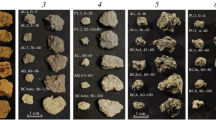Abstract
With the help of computed X-ray microtomography with a resolution of 2.75 μm, changes in the microstructure and pore space of aggregates of 3 mm in diameter from the virgin soddy-podzolic soil (Glossic Retisol (Loamic)) in the air-dry, capillary-moistened, and frozen states after five freeze–thaw cycles were studied in a laboratory experiment. The freezing of the samples was performed at their capillary moistening. It was shown that capillary moistening of initially air-dry samples from the humus (AY), eluvial (EL), and illuvial (BT1) horizons at room temperature resulted in the development of the platy, fine vesicular, and angular blocky microstructure, respectively. The total volume of tomographically visible pores >10 μm increased by 1.3, 2.2, and 3.4 times, respectively. After freeze–thaw cycles, frozen aggregates partly preserved the structural arrangement formed during the capillary moistening. At the same time, in the frozen aggregate from the AY horizon, the total tomographic porosity decreased to the initial level of the air-dry soil. In the frozen aggregate from the EL horizon, large vesicular pores were formed, owing to which the total pore volume retained its increased values. The resistance of aggregate shape to the action of freeze–thaw cycles differed. The aggregate from the EL horizon completely lost its original configuration by the end of the experiment. The aggregate from the AY horizon displayed definite features of sagging after five freeze–thaw cycles, whereas the aggregate from the BT1 horizon preserved its original configuration.
Similar content being viewed by others
References
L. A. Vaisberg and E. E. Kameneva, “Changes in the structure of rocks upon cyclic freezing and thawing,” Obogashch. Rud (S.-Peterburg), No. 2 (356), 28–31 (2015). doi 10.17580/or.2015.02.06
S. V. Gubin, “Structuring in tundra cryogenic nongley soils (tundra Cryosols),” Pochvovedenie, No. 10, 62–70 (1993).
E. V. Zhangurov, M. P. Lebedeva, and I. V. Zaboeva, “Microstructure of genetic horizons in automorphic soils of the Timan Ridge,” Eurasian Soil Sci. 44, 561–271 (2011). doi 10.1134/S1064229311030203
L. L. Shishov, V. D. Tonkonogov, I. I. Lebedeva, and M. I. Gerasimova, Classification and Diagnostic System of Russian Soils (Oikumena, Smolensk, 2004) [in Russian].
V. N. Konishchev and M. A. Faustova, “Microstructure of cover loess formations in the Bol’shezemel’skaya tundra,” in Geology of the Cenozoic of the North of European Part of Soviet Union (Moscow State Univ., Moscow, 1966), pp. 167–177.
V. N. Konishchev and V. V. Rogov, “Micromorphology of cryogenic soils and grounds,” Pochvovedenie, No. 2, 119–125 (1977).
I. T. Kosheleva, “Micromorphology of tundra soils as a possible indicator of their genesis,” Izv. Akad. Nauk SSSR, Ser. Geogr., No. 3, 25–30 (1958).
Microstructure of Permafrost, Ed. by E. D. Ershov (Moscow State Univ., Moscow, 1988) [in Russian].
E. I. Parfenova and E. A. Yarilova, Manual for Micromorphological Studies in Soil Science (Nauka, Moscow, 1977) [in Russian].
A. V. Pastukhov, “Micromorphological structure of permafrost and seasonally freezing loamy soils of European northeast,” Izv. Komi. Nauch. Tsentra, Ural. Otd., Ross. Akad. Nauk, No. 4 (12), 30–37 (2012).
V. V. Rogov, Fundamentals of Cryogenesis (Geo, Novosibirsk, 2009) [in Russian].
K. A. Romanenko, V.V. Rogov, A. V. Yudina, K. N. Abrosimov, E. B. Skvortsova, and A. N. Kurchatova, “Frozen soils and sediments microstructure X-ray tomography study: methods, approaches, perspectives,” Byull. Pochv. Inst. im. V.V. Dokuchaeva, No. 83, 103–117 (2016). doi 10.19047/0136-1694-2016-83-103-117
E. B. Skvortsova and D. R. Morozov, “Micromorphological classification and diagnostics of the pore structure of soil,” Pochvovedenie, No. 6, 49–56 (1993).
E. B. Skvortsova and P. M. Sapozhnikov, “Transformation of the pore space of compacted soils during seasonal freezing and thawing,” Eurasian Soil Sci. 31, 1245–1255 (1998).
L. A. Sokolov and S. A. Shoba, “Influence of freezing and thawing on soil properties in the zones of recreation load,” Nauch. Dokl. Vyssh. Shkoly, Biol. Nauki, No. 7, 104–110 (1982).
T. V. Tursina, “Micromorphological diagnostics of cryogenic features in soils,” Proceedings of IV All-Russia Conference, Abstracts of Papers (Syktyvkar, 1985), pp. 32–33.
K. Hazirbaba, Y. Zhang, and H. J. Leroy, “Evaluation of temperature and freeze-thaw effects on excess pore pressure generation of fine-grained soils,” Soil Dyn. Earthquake Eng. 31 (3), 372–384 (2011). doi 10.1016/ j.soildyn.2010.09.006
A. L. H. Hugh, “Soil freeze–thaw cycle experiments: Trends, methodological weaknesses and suggested improvements,” Soil Biol. Biochem. 39 (5), 977–986 (2007). doi 10.1016/j.soilbio.2006.11.017
IUSS Working Group WRB, World Reference Base for Soil Resources 2014: Update 2015, International Soil Classification System for Naming Soils and Creating Legends for Soil Maps, Word Soil Resources Report No. 106 (Food and Agriculture Organization, Rome, 2015).
C. M. C. Laplante, PhD Thesis (1998).
T. Oztas and F. Fayetorbay, “Effect of freezing and thawing processes on soil aggregate stability,” Catena 52 (1), 1–8 (2003). doi 10.1016/s0341-8162(02)00177-7
G. Pardini, G. V. Guidi, R. Pini, D. Regues, and F. Gallart, “Structure and porosity of smectitic mudrocks as affected by experimental wetting-drying cycles and freezing-thawing cycles,” Catena 27 (3–4), 149–165 (1996).
J. Six, H. Bossuyt, S. Degryse, and K. Denef, “A history of research on the link between (micro) aggregates, soil biota, and soil organic matter dynamics,” Soil Tillage Res. 79, 7–31 (2004).
I. A. Taina, R. J. Heck, W. Deen, and E. Y. T. Ma, “Quantification of freeze–thaw related structure in cultivated topsoils using x-ray computed tomography,” Can. J. Soil Sci. 93, 533–553 (2013).
J. K. Torrance, T. Elliot, R. Martin, and R. J. Heck, “X-ray computed tomography of frozen soil,” Cold Reg. Sci. Technol. 53, 75–82 (2008).
T.-L. Wang, J.-Q. Bu, L. Xu, Y. Wang, and H. Yan, “Thaw subsidence properties of soils under repeated freeze-thaw cycles,” Chin. J. Geotech. Eng. 36 (4), 625–632 (2014). doi 10.11779/CJGE201404005
Author information
Authors and Affiliations
Corresponding author
Additional information
Original Russian Text © E.B. Skvortsova, E.V. Shein, K.N. Abrosimov, K.A. Romanenko, A.V. Yudina, V.V. Klyueva, D.D. Khaidapova, V.V. Rogov, 2018, published in Pochvovedenie, 2018, No. 2, pp. 187–196.
Rights and permissions
About this article
Cite this article
Skvortsova, E.B., Shein, E.V., Abrosimov, K.N. et al. The Impact of Multiple Freeze–Thaw Cycles on the Microstructure of Aggregates from a Soddy-Podzolic Soil: A Microtomographic Analysis. Eurasian Soil Sc. 51, 190–198 (2018). https://doi.org/10.1134/S1064229318020102
Received:
Published:
Issue Date:
DOI: https://doi.org/10.1134/S1064229318020102




